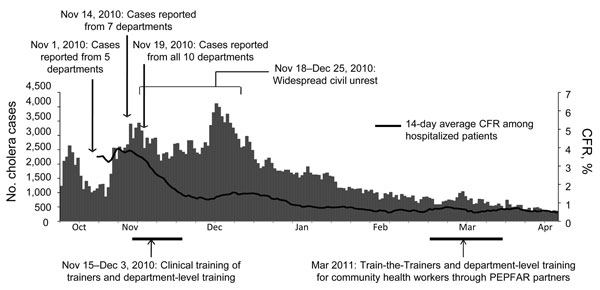Volume 17, Number 11—November 2011
THEME ISSUE
CHOLERA IN HAITI
Synopsis
Rapid Development and Use of a Nationwide Training Program for Cholera Management, Haiti, 2010
Figure

Figure. Major events in training, number of cholera cases reported to Ministère de la Santé Publique et de la Population (MSPP) national surveillance by day, and smoothed 14-day case-fatality rate (CFR) for hospitalized calculated from MSPP surveillance data during the cholera epidemic in Haiti, October 20, 2010–April 20, 2011. The first cases were confirmed in Artibonite Department October 21, 2010; by November 19, cholera was reported in all 10 departments in Haiti. PEPFAR, President’s Emergency Program for AIDS Relief.
Page created: October 26, 2011
Page updated: October 26, 2011
Page reviewed: October 26, 2011
The conclusions, findings, and opinions expressed by authors contributing to this journal do not necessarily reflect the official position of the U.S. Department of Health and Human Services, the Public Health Service, the Centers for Disease Control and Prevention, or the authors' affiliated institutions. Use of trade names is for identification only and does not imply endorsement by any of the groups named above.